stop start TOYOTA PRIUS PLUG-IN HYBRID 2016 Workshop Manual
[x] Cancel search | Manufacturer: TOYOTA, Model Year: 2016, Model line: PRIUS PLUG-IN HYBRID, Model: TOYOTA PRIUS PLUG-IN HYBRID 2016Pages: 744, PDF Size: 84.41 MB
Page 474 of 744
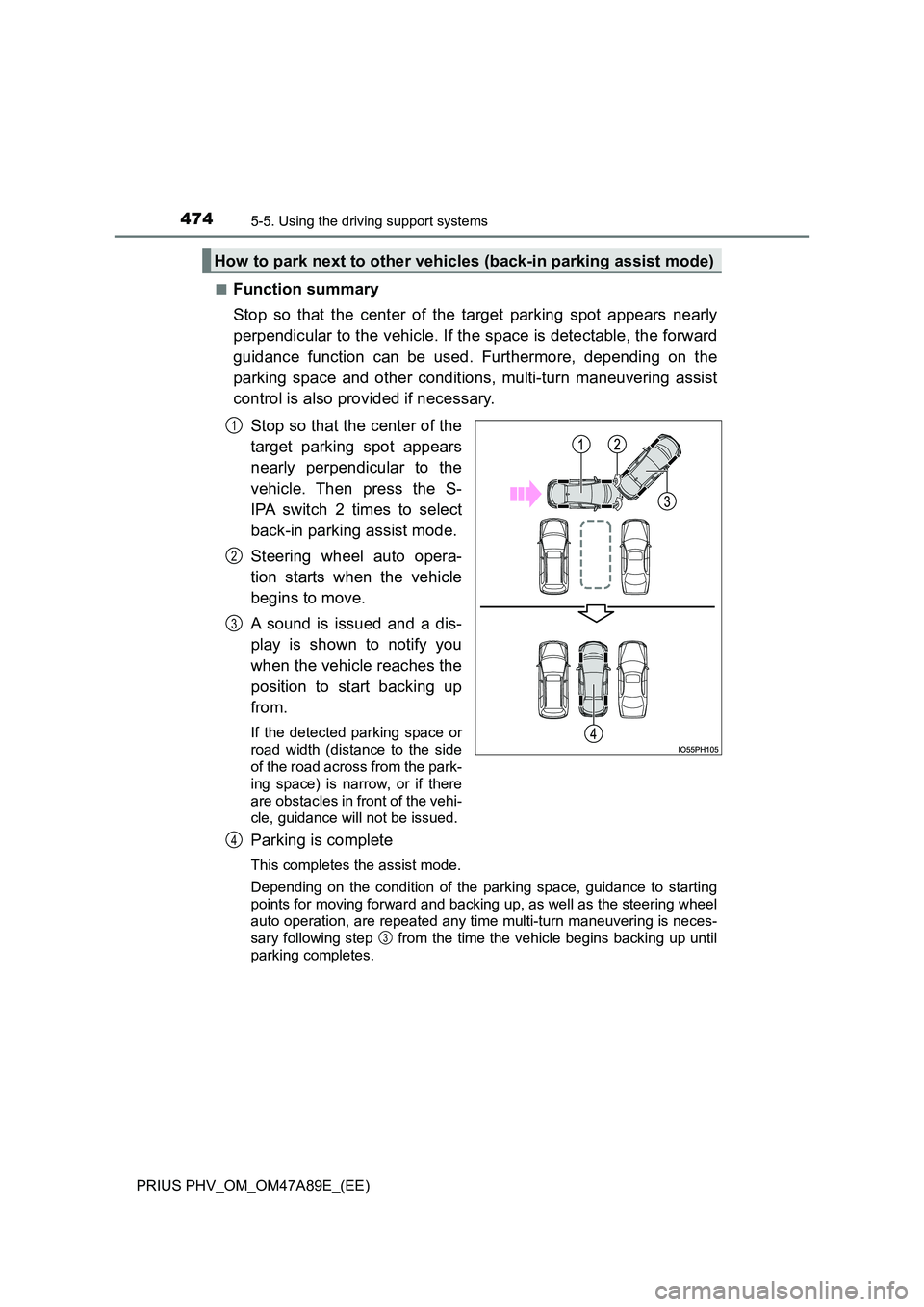
4745-5. Using the driving support systems
PRIUS PHV_OM_OM47A89E_(EE)
■Function summary
Stop so that the center of the target parking spot appears nearly
perpendicular to the vehicle. If the space is detectable, the forward
guidance function can be used. Furthermore, depending on the
parking space and other conditions, multi-turn maneuvering assist
control is also provided if necessary.
Stop so that the center of the
target parking spot appears
nearly perpendicular to the
vehicle. Then press the S-
IPA switch 2 times to select
back-in parking assist mode.
Steering wheel auto opera-
tion starts when the vehicle
begins to move.
A sound is issued and a dis-
play is shown to notify you
when the vehicle reaches the
position to start backing up
from.
If the detected parking space or
road width (distance to the side
of the road across from the park-
ing space) is narrow, or if there
are obstacles in front of the vehi-
cle, guidance will not be issued.
Parking is complete
This completes the assist mode.
Depending on the condition of the parking space, guidance to starting
points for moving forward and backing up, as well as the steering wheel
auto operation, are repeated any time multi-turn maneuvering is neces-
sary following step from the time the vehicle begins backing up until
parking completes.
How to park next to other vehicles (back-in parking assist mode)
1
2
3
4
3
Page 476 of 744
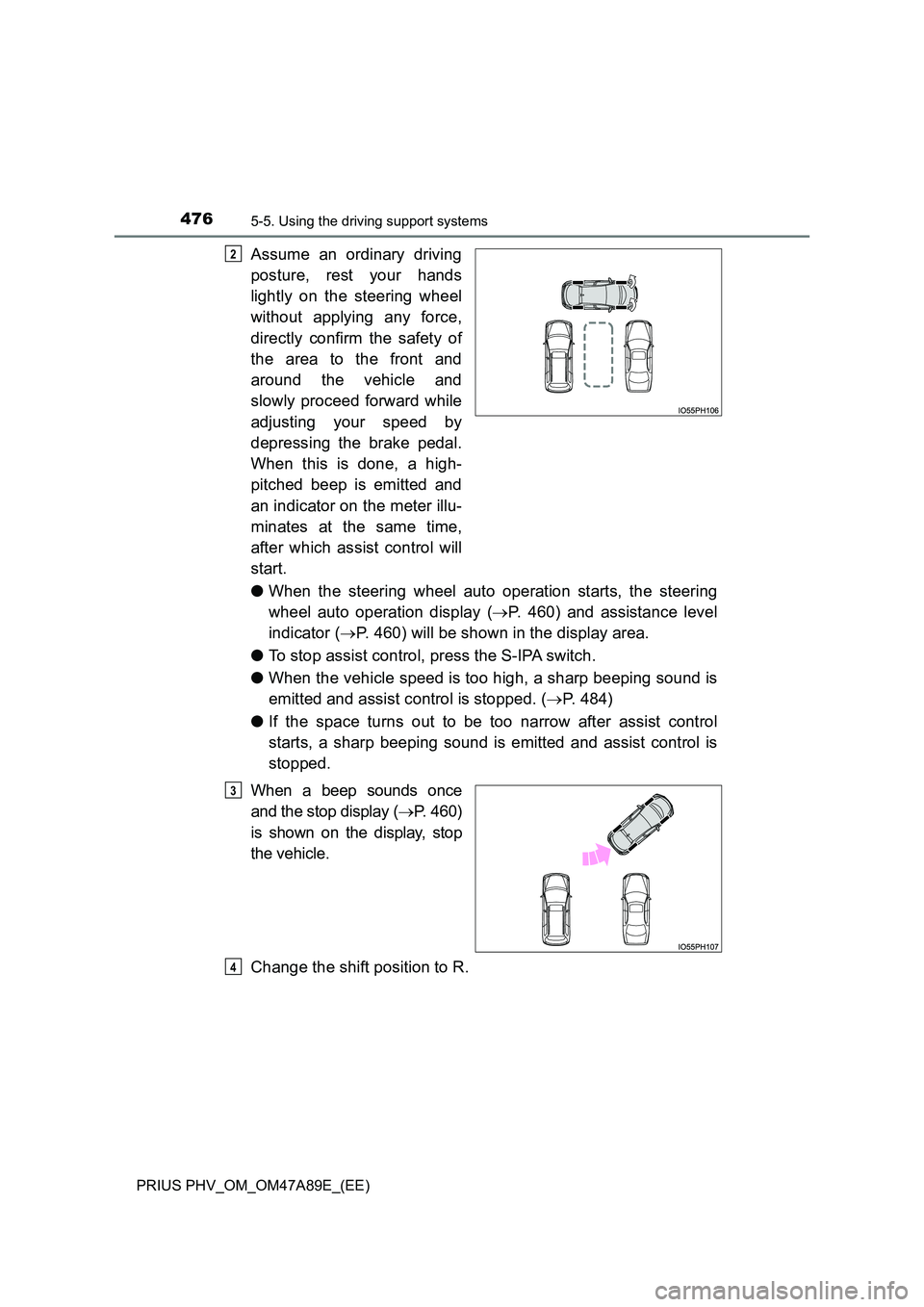
4765-5. Using the driving support systems
PRIUS PHV_OM_OM47A89E_(EE)
Assume an ordinary driving
posture, rest your hands
lightly on the steering wheel
without applying any force,
directly confirm the safety of
the area to the front and
around the vehicle and
slowly proceed forward while
adjusting your speed by
depressing the brake pedal.
When this is done, a high-
pitched beep is emitted and
an indicator on the meter illu-
minates at the same time,
after which assist control will
start.
● When the steering wheel auto operation starts, the steering
wheel auto operation display ( P. 460) and assistance level
indicator ( P. 460) will be shown in the display area.
● To stop assist control, press the S-IPA switch.
● When the vehicle speed is too high, a sharp beeping sound is
emitted and assist control is stopped. ( P. 484)
● If the space turns out to be too narrow after assist control
starts, a sharp beeping sound is emitted and assist control is
stopped.
When a beep sounds once
and the stop display ( P. 460)
is shown on the display, stop
the vehicle.
Change the shift position to R.
2
3
4
Page 481 of 744
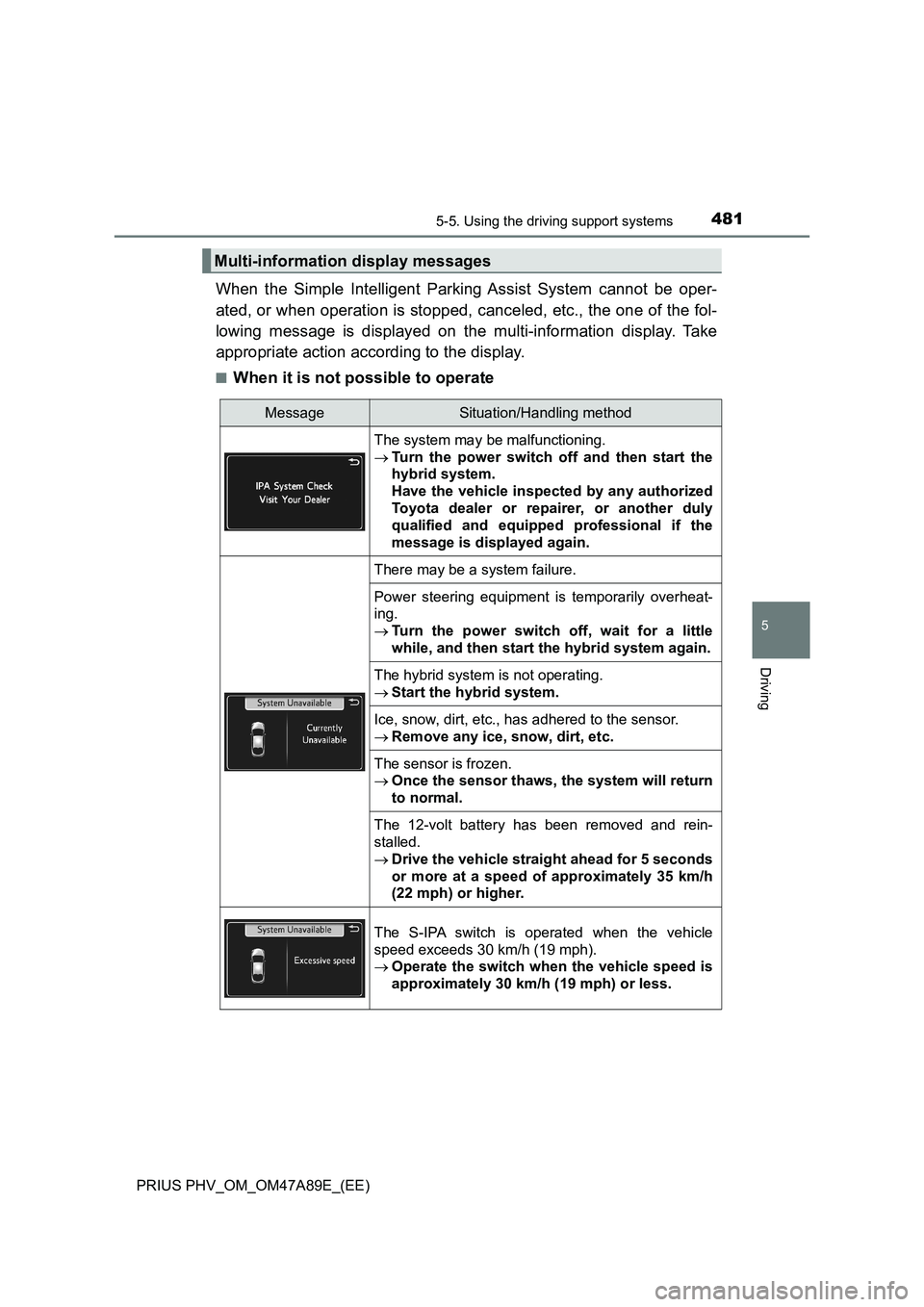
4815-5. Using the driving support systems
PRIUS PHV_OM_OM47A89E_(EE)
5
Driving
When the Simple Intelligent Parking Assist System cannot be oper-
ated, or when operation is stopped, canceled, etc., the one of the fol-
lowing message is displayed on the multi-information display. Take
appropriate action according to the display.
■When it is not possible to operate
Multi-information display messages
MessageSituation/Handling method
The system may be malfunctioning.
Turn the power switch off and then start the
hybrid system.
Have the vehicle inspected by any authorized
Toyota dealer or repairer, or another duly
qualified and equipped professional if the
message is displayed again.
There may be a system failure.
Power steering equipment is temporarily overheat-
ing.
Turn the power switch off, wait for a little
while, and then start the hybrid system again.
The hybrid system is not operating.
Start the hybrid system.
Ice, snow, dirt, etc., has adhered to the sensor.
Remove any ice, snow, dirt, etc.
The sensor is frozen.
Once the sensor thaws, the system will return
to normal.
The 12-volt battery has been removed and rein-
stalled.
Drive the vehicle straight ahead for 5 seconds
or more at a speed of approximately 35 km/h
(22 mph) or higher.
The S-IPA switch is operated when the vehicle
speed exceeds 30 km/h (19 mph).
Operate the switch when the vehicle speed is
approximately 30 km/h (19 mph) or less.
Page 482 of 744
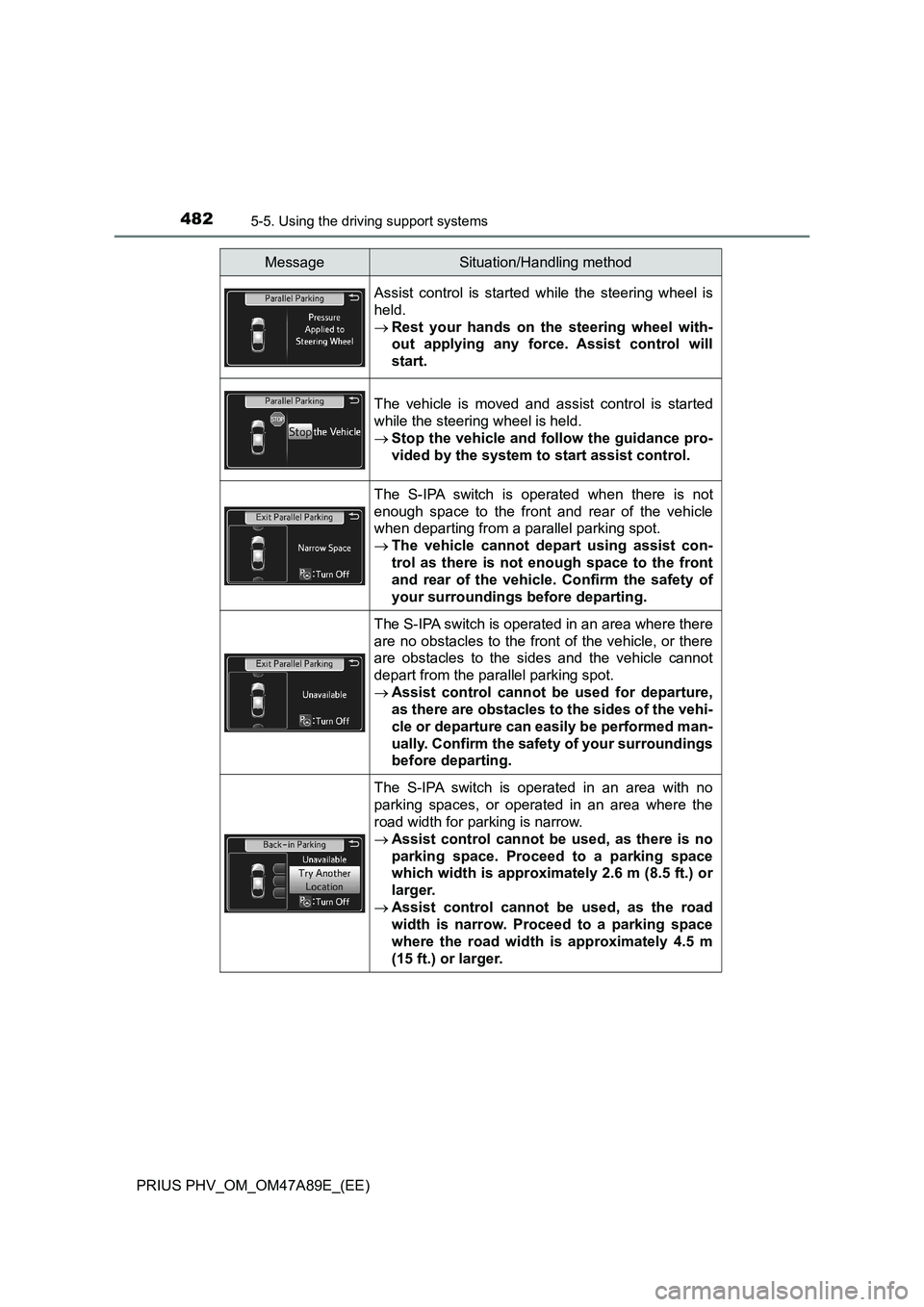
4825-5. Using the driving support systems
PRIUS PHV_OM_OM47A89E_(EE)
Assist control is started while the steering wheel is
held.
Rest your hands on the steering wheel with-
out applying any force. Assist control will
start.
The vehicle is moved and assist control is started
while the steering wheel is held.
Stop the vehicle and follow the guidance pro-
vided by the system to start assist control.
The S-IPA switch is operated when there is not
enough space to the front and rear of the vehicle
when departing from a parallel parking spot.
The vehicle cannot depart using assist con-
trol as there is not enough space to the front
and rear of the vehicle. Confirm the safety of
your surroundings before departing.
The S-IPA switch is operated in an area where there
are no obstacles to the front of the vehicle, or there
are obstacles to the sides and the vehicle cannot
depart from the parallel parking spot.
Assist control cannot be used for departure,
as there are obstacles to the sides of the vehi-
cle or departure can easily be performed man-
ually. Confirm the safety of your surroundings
before departing.
The S-IPA switch is operated in an area with no
parking spaces, or operated in an area where the
road width for parking is narrow.
Assist control cannot be used, as there is no
parking space. Proceed to a parking space
which width is approximately 2.6 m (8.5 ft.) or
larger.
Assist control cannot be used, as the road
width is narrow. Proceed to a parking space
where the road width is approximately 4.5 m
(15 ft.) or larger.
MessageSituation/Handling method
Page 484 of 744

4845-5. Using the driving support systems
PRIUS PHV_OM_OM47A89E_(EE)■
When the operation is suspended
When assist control starts, the vehicle proceeds in a
direction opposite to the guidance.
Follow the guidance provided by the system
to proceed forward.
The maximum number of movements for multi-turn
maneuvering is reached during assist control, or the
target parking spot cannot be reached due to the
control being used on a road with steep grade.
Follow the assist control guidance and use
the system in a wide space that does not have
a steep grade.
MessageSituation/Handling method
MessageSituation/Handling method
The driver holds the
steering wheel during
assist control.Stop the vehicle and
rest your hands on the
steering wheel without
applying any force.
Then press the S-IPA
switch to restart assist
control.
The vehicle speed
exceeds 7 km/h
(4 mph) during assist
control.
The S-IPA switch is
pressed while assist
control is temporarily
stopped and the
steering wheel is
firmly held.Rest your hands on the
steering wheel without
applying any force.
Then stop the vehicle to
restart assist control.
The S-IPA switch is
pressed while assist
control is temporarily
stopped and the vehi-
cle is moving.
Page 485 of 744
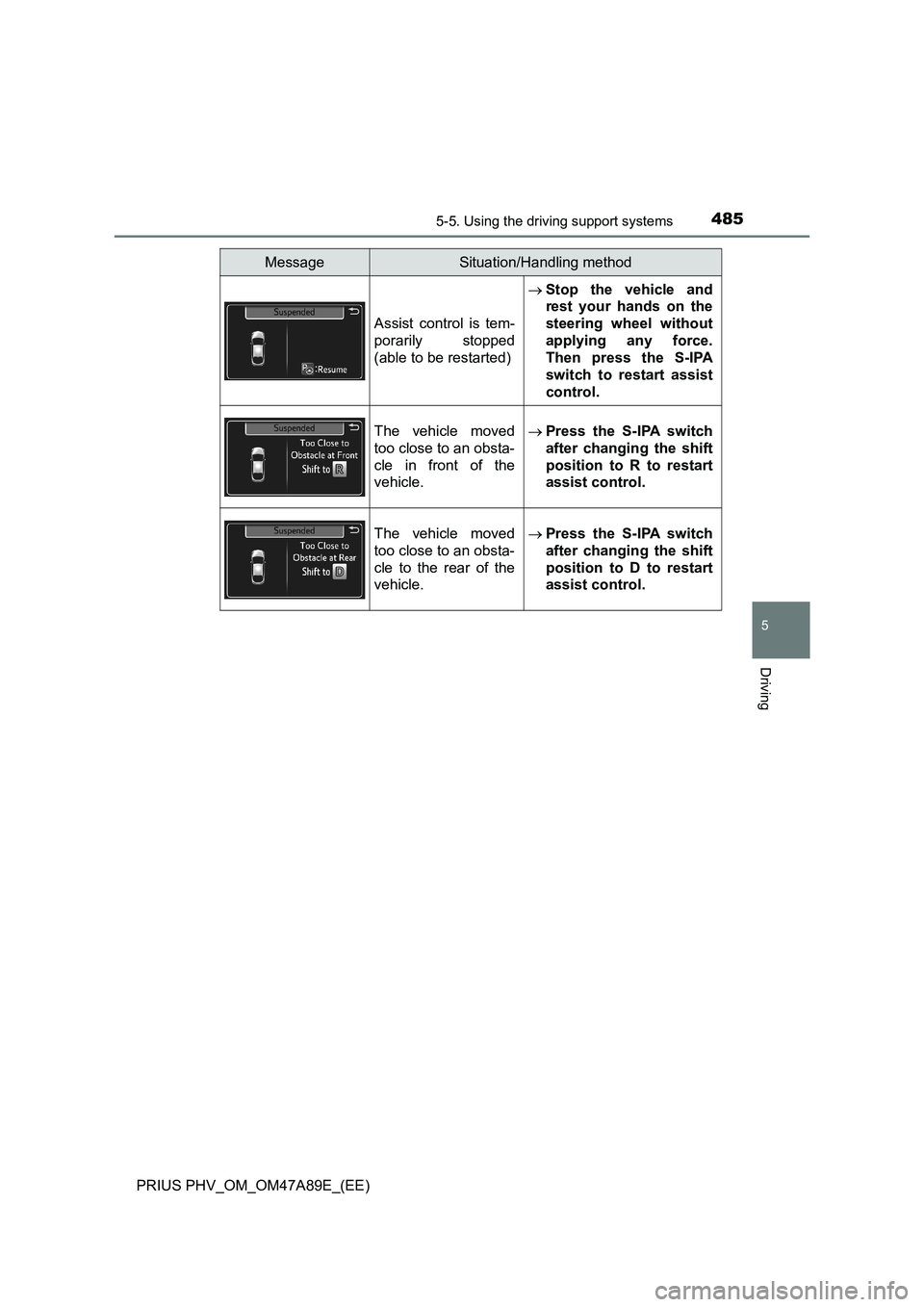
4855-5. Using the driving support systems
PRIUS PHV_OM_OM47A89E_(EE)
5
Driving
Assist control is tem-
porarily stopped
(able to be restarted)Stop the vehicle and
rest your hands on the
steering wheel without
applying any force.
Then press the S-IPA
switch to restart assist
control.
The vehicle moved
too close to an obsta-
cle in front of the
vehicle.Press the S-IPA switch
after changing the shift
position to R to restart
assist control.
The vehicle moved
too close to an obsta-
cle to the rear of the
vehicle.Press the S-IPA switch
after changing the shift
position to D to restart
assist control.
MessageSituation/Handling method
Page 490 of 744

4905-5. Using the driving support systems
PRIUS PHV_OM_OM47A89E_(EE)
WARNING
●Observe the following precautions, as the sensors may stop functioning
properly which may lead to an accident.
• Do not subject the sensor to strong shocks by hitting it, etc. The sen-
sors may not function properly.
• When using a high-pressure washer to wash the vehicle, do not spray
water directly on the sensors. Equipment may not function properly if
subjected to an impact from strong water pressure. If the vehicle
bumper strikes something, equipment may not operate properly due to
a sensor malfunction. Have the vehicle inspected at any authorized
Toyota dealer or repairer, or another duly qualified and equipped profes-
sional.
● In the following situations, the sensors may not operate normally and may
lead to an accident. Drive carefully.
• Obstacles cannot be detected in the side areas until a scan of the side
areas is completed. ( P. 438)
• Even after the scan of the side areas is completed, obstacles such as
other vehicles, people or animals that approach from the sides cannot
be detected.
• The sensor is frozen (if it thaws, the system returns to normal).
A warning message may display at particularly low temperatures due to
the sensor freezing and it may not detect parked vehicles.
• The sensor is blocked by someone’s hand.
• The vehicle is tilted a large amount.
• The temperature is extremely hot or cold.
• The vehicle is driven on undulating roads, slopes, gravel roads, in areas
with tall grass, etc.
• An ultrasonic wave source is nearby, such as the horn or sensors of
another vehicle, a motorcycle engine or the air brake of a large vehicle.
• Heavy rain or a water strikes the vehicle.
• The angle of the sensor may be deviated when assist control starts
even if there is a parked vehicle in the target parking spot. Have the
vehicle inspected at any authorized Toyota dealer or repairer, or
another duly qualified and equipped professional.
• Do not install any accessories within the sensor detection range.
Page 491 of 744

4915-5. Using the driving support systems
PRIUS PHV_OM_OM47A89E_(EE)
5
Driving
Driving assist systems
◆ECB (Electronically Controlled Brake System)
The electronically controlled system generates braking force corre-
sponding to the brake operation
◆ABS (Anti-lock Brake System)
Helps to prevent wheel lock when the brakes are applied suddenly,
or if the brakes are applied while driving on a slippery road surface
◆Brake assist
Generates an increased level of braking force after the brake pedal
is depressed when the system detects a panic stop situation
◆VSC (Vehicle Stability Control)
Helps the driver to control skidding when swerving suddenly or
turning on slippery road surfaces.
◆VSC+ (Vehicle Stability Control+)
Provides cooperative control of the ABS, TRC, VSC and EPS.
Helps to maintain directional stability when swerving on slippery
road surfaces by controlling steering performance.
◆TRC (Traction Control)
Helps to maintain drive power and prevent the drive wheels from
spinning when starting the vehicle or accelerating on slippery roads
◆Hill-start assist control
Helps to reduce the backward movement of the vehicle when start-
ing on an uphill
To help enhance driving safety and performance, the following
systems operate automatically in response to various driving
situations. Be aware, however, that these systems are supple-
mentary and should not be relied upon too heavily when operat-
ing the vehicle.
Page 494 of 744
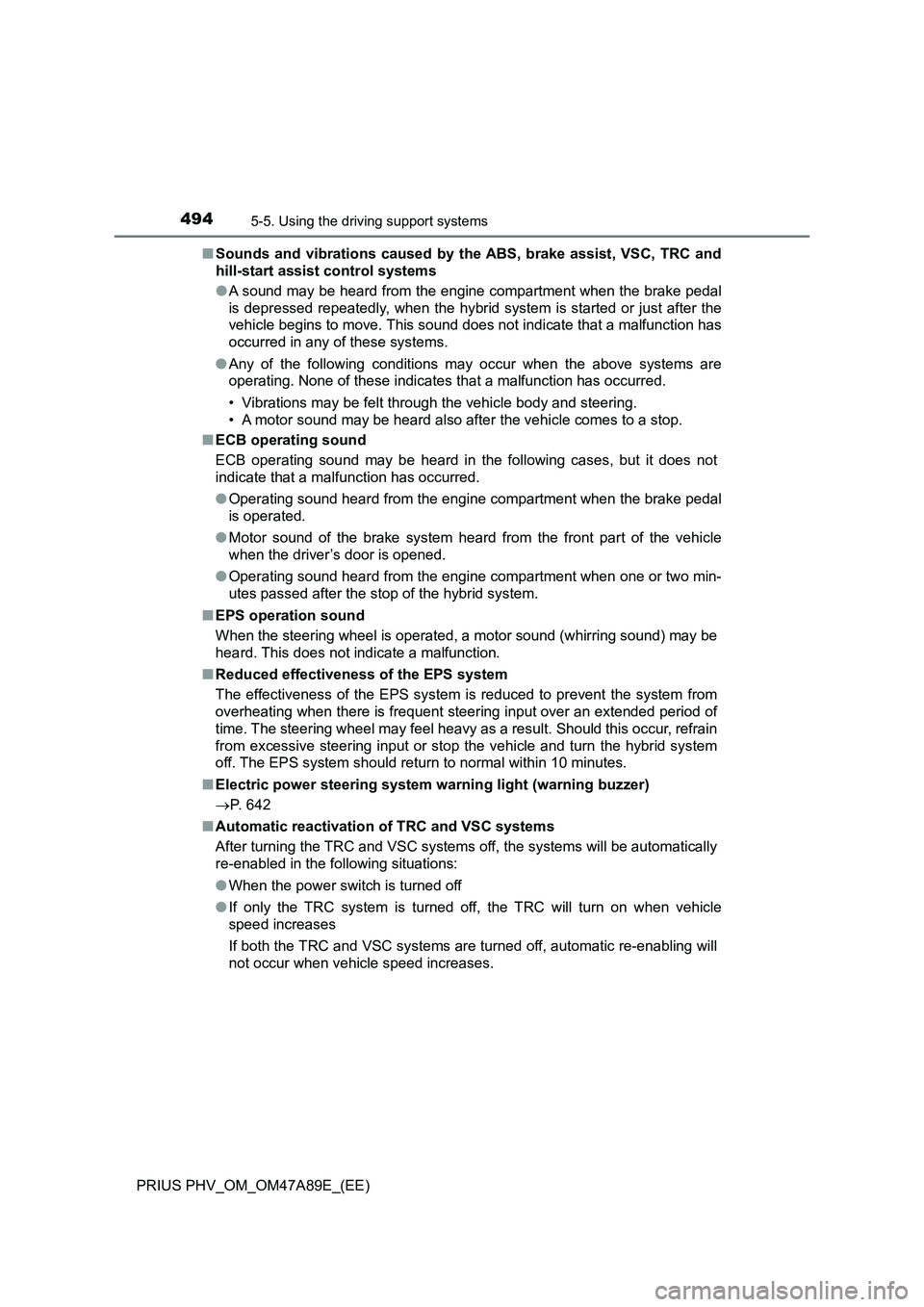
4945-5. Using the driving support systems
PRIUS PHV_OM_OM47A89E_(EE)■Sounds and vibrations caused by the ABS, brake assist, VSC, TRC and
hill-start assist control systems
●A sound may be heard from the engine compartment when the brake pedal
is depressed repeatedly, when the hybrid system is started or just after the
vehicle begins to move. This sound does not indicate that a malfunction has
occurred in any of these systems.
●Any of the following conditions may occur when the above systems are
operating. None of these indicates that a malfunction has occurred.
• Vibrations may be felt through the vehicle body and steering.
• A motor sound may be heard also after the vehicle comes to a stop.
■ECB operating sound
ECB operating sound may be heard in the following cases, but it does not
indicate that a malfunction has occurred.
●Operating sound heard from the engine compartment when the brake pedal
is operated.
●Motor sound of the brake system heard from the front part of the vehicle
when the driver’s door is opened.
●Operating sound heard from the engine compartment when one or two min-
utes passed after the stop of the hybrid system.
■EPS operation sound
When the steering wheel is operated, a motor sound (whirring sound) may be
heard. This does not indicate a malfunction.
■Reduced effectiveness of the EPS system
The effectiveness of the EPS system is reduced to prevent the system from
overheating when there is frequent steering input over an extended period of
time. The steering wheel may feel heavy as a result. Should this occur, refrain
from excessive steering input or stop the vehicle and turn the hybrid system
off. The EPS system should return to normal within 10 minutes.
■Electric power steering system warning light (warning buzzer)
P. 642
■Automatic reactivation of TRC and VSC systems
After turning the TRC and VSC systems off, the systems will be automatically
re-enabled in the following situations:
●When the power switch is turned off
●If only the TRC system is turned off, the TRC will turn on when vehicle
speed increases
If both the TRC and VSC systems are turned off, automatic re-enabling will
not occur when vehicle speed increases.
Page 495 of 744

4955-5. Using the driving support systems
PRIUS PHV_OM_OM47A89E_(EE)
5
Driving
■Operating conditions of hill-start assist control
When the following four conditions are met, the hill-start assist control will
operate:
●The shift position is in a position other than P or N (when starting off forward/
backward on an upward incline)
●The vehicle is stopped
●The accelerator pedal is not depressed
●The parking brake is not engaged
■Automatic system cancelation of hill-start assist control
The hill-start assist control will turn off in any of the following situations:
●Shift the shift position to P or N
●The accelerator pedal is depressed
●The parking brake is engaged
●Approximately 2 seconds elapse after the brake pedal is released
■Operating conditions of emergency brake signal
When the following three conditions are met, the emergency brake signal will
operate:
●The emergency flashers are off
●Actual vehicle speed is over 55 km/h (35 mph)
●The brake pedal is depressed in a manner that cause the system to judge
from the vehicle deceleration that this is a sudden braking operation
■Automatic system cancelation of emergency brake signal
The emergency brake signal will turn off in any of the following situations:
●The emergency flashers are turned on
●The brake pedal is released
●The system judges from the vehicle deceleration that is not a sudden brak-
ing operation